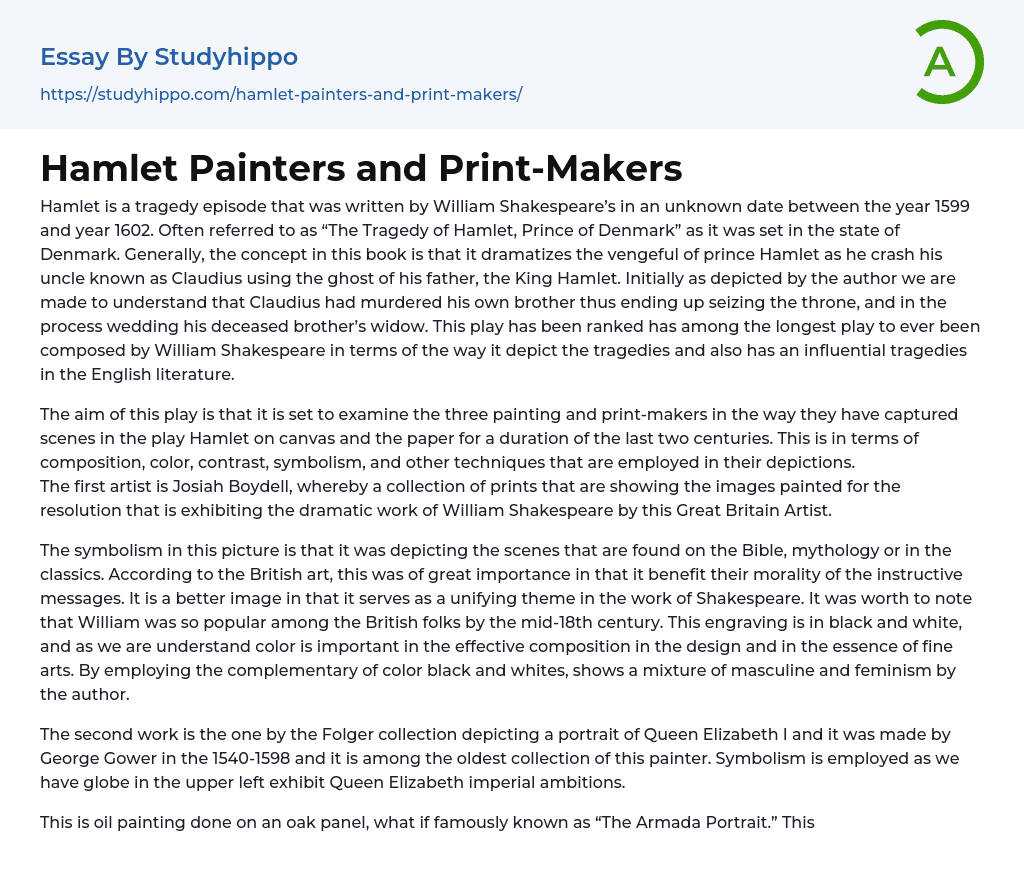William Shakespeare wrote "Hamlet" between 1599 and 1602. It is a tragic episode known as "The Tragedy of Hamlet, Prince of Denmark." The play is set in Denmark and revolves around Prince Hamlet's quest for revenge against his uncle, Claudius. Hamlet believes that Claudius killed his father, King Hamlet. Moreover, the author portrays Claudius not only as the murderer but also as the one who took the throne and married his deceased brother's wife. "Hamlet" is considered one of Shakespeare's longest works and receives praise for its portrayal of tragedy and its significant impact on English literature.
This play aims to analyze the paintings and prints made by three artists in the last two centuries, which portray scenes from Hamlet. The main focus will be on the techniques used by these artists, such as composition, color, contrast, symbolism, among others. The first artist highlighte
...d is Josiah Boydell, who produced a series of prints featuring his paintings influenced by William Shakespeare's plays. These prints frequently include symbols from biblical narratives, mythology, or classical literature.
The British art placed great significance on the informative messages conveyed by this engraving, which also served as a unifying theme in Shakespeare's works. By the mid-18th century, William had gained immense popularity among the British populace. The black and white arrangement of this engraving underscores the importance of color in both effective design and fine arts. The inclusion of complementary colors, black and white, expresses a combination of masculinity and femininity that was intended by the author.
The second work in the Folger collection is a portrait of Queen Elizabeth I, created by George Gower in the years 1540-1598. This painting is one o
the oldest pieces by Gower. Symbolism is employed in the painting, with a globe in the upper left corner representing Queen Elizabeth's imperial ambitions. The painting, also known as "The Armada Portrait," is an oil painting on an oak panel. It was created to commemorate the Great War, during which the English Fleet defeated the invading Spanish Armada. The painting uses symbolism again, with the imperial crown reflecting the Queen's equality with the Roman Emperor and portraying her as an Empress of the world.
Her dress is black and white, symbolizing her virginity, which was her preferred choice. Additionally, we will analyze two lithographs by Eugene Delacroix, the third and last work we will consider in relation to William Shakespeare's play Hamlet. The first lithograph (1834) portrays the scene where the queen attempts to console Hamlet, while the second image (1835) depicts Hamlet's encounter with the ghost of his father. In these two paintings, Delacroix utilizes black as a prominent color, reflecting his personal preference. He famously regarded gray as the enemy of all painting and lamented that all earth colors should be prohibited. The first image displays the anguish Hamlet experiences following his father's murder, while the second image symbolizes the profound impact his father's spirit has on his own soul, driving him to seek revenge against the perpetrators.
- Apoptosis essays
- Asthma essays
- Black Death essays
- Breast Cancer essays
- Cholesterol essays
- Chronic essays
- Chronic Pain essays
- Death essays
- Diabetes essays
- Down Syndrome essays
- Epidemic essays
- Hypertension essays
- Infection essays
- Infertility essays
- Myocardial Infarction essays
- Pain essays
- Pathogen essays
- Pregnancy essays
- Sexually Transmitted Disease essays
- Symptom essays
- Tuskegee Syphilis Experiment essays
- Water supply essays
- Allegory essays
- Alliteration essays
- Comedy essays
- Comic book essays
- Drama essays
- Dystopia essays
- Fairy Tale essays
- Fantasy essays
- Fiction essays
- Ghost essays
- Gothic Fiction essays
- Gothic Literature essays
- Irony essays
- Legend essays
- Memoir essays
- Novel essays
- Poetry essays
- Satire essays
- Science Fiction essays
- Short Story essays
- The western essays
- Tragedy essays
- Witchcraft essays




